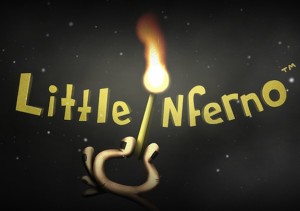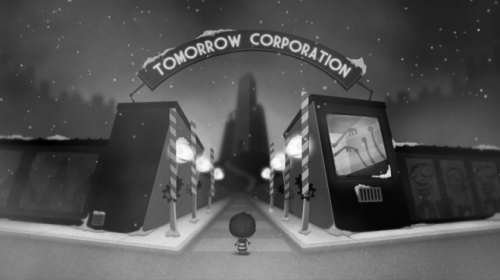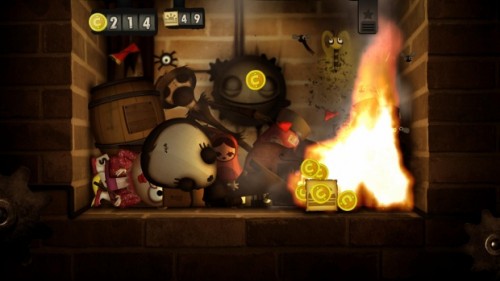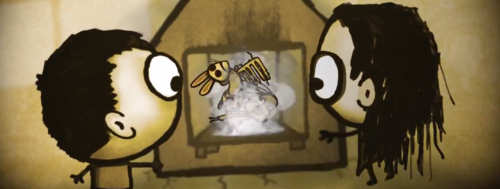 Little Inferno
Little Inferno
Available on PC, Wii U, iOS, Android
Buy on Steam
The world is getting colder. Up past your chimney, the snow is coming down thick and fast. It’s been this way for years, but nobody seems to know, or really care, why. Whatever the reason, weather like this…it can’t possibly last forever. So why bother trying to figure it out?
Why bother going outside at all when you’ve got your very own Little Inferno Entertainment Fireplace, courtesy of Tomorrow Corporation? It’ll keep you warm and entertained forever, or as long as you’ve got stuff to burn, which is basically saying the same thing. Thanks to the many letters and catalogs that keep arriving mysteriously on your fireside mantel, it will be a long while before you run out of stuff to burn. Of course that, too, can’t possibly last forever. But why worry about the future, or the past, when you can live in an eternally incandescent present?

The aptly named Tomorrow Corporation is more than just a faceless, philanthropic corporate entity within the world of Little Inferno; it’s also the name of the independent game development studio made up of former World of Goo developers Kyle Gabler and Allan Blomquist, along with Henry Hatsworth‘s Kyle Gray. Combining elements of Seussian satire, Tim Burton-esque morbidity, and religious awe, Little Inferno (now available on multiple PC and mobile operating systems, as well as Wii U) delivers a harsh but winking upbraiding of the gaming industry, the wider entertainment, and industry as a whole; so harsh, in fact, that many critics at the time of its November 2012 release just couldn’t stomach it, finding the game unplayable and impossible to recommend. As the most important selling season of the year reaches its climax, however, and the various app stores flood with millions of Christmas and post-Christmas shoppers, this weird, cozy anti-game is worth revisiting—if nothing else, as a cautionary tale.
I call it an anti-game because, while there are moments of effervescent joy to be found in the playing, Little Inferno‘s best elements sit just outside the frame of its purposefully limited gameplay canvas, which tends closer to “toy” than “game.” To describe Little Inferno‘s design philosophy as “one note” would be to severely underrepresent its monocular POV and single-minded sense of purpose. In a rare example of truth in advertising, the Little Inferno Entertainment Fireplace does exactly and only what the packaging suggests. The player is offered only three ways of interacting with its cheerfully bleak world: click through Tomorrow Corporation’s various themed catalogs to send items to your mailbox, drag items out to stack them just so in the fireplace, and click anywhere within the fireplace to ignite that pile of old toys, correspondences, binding contracts or personal memories. And until its horizon-expanding conclusion, Little Inferno provides you only one view of the world, staring into the bright heart of the fire itself. As your neighbor, Sugar Plumps, writes, “I can stare into the fire forever, but not backwards… .”
Letters from Sugar Plumps and a few other key characters, including Miss Nancy, CEO of Tomorrow Corporation; and The Weatherman, “reporting from the Weather Balloon, over the smoke stacks, over the city,” form the core of Little Inferno‘s narrative—a narrative that seems at times absurd, at times ominous, but always serves to reinforce the critiques leveled by the game’s structure. Textual elements, such as the refrain of “it can’t last forever,” repeated references to a relentless, irreversible march forward (Sugar Plumps’s typography is idiosyncratic at best; the reason, as we find out later, is that her keyboard has lost its Delete key, so that “The possibilities go FORWARD forever! But can’t ever go back.”), and the forbiddingly cold weather (Sugar Plumps writes in another letter: “The city is fillllled with people! … I can see theeeir chimneys…and smell the smoooke! … But even though they are everywhere…they are far away like leeetle burning galaxies…with leeettle smoking chimneys on their heads! Ooooo it makes me cooold!”)—even if their meaning is not immediately clear, these all form the emotional backdrop for the player’s activities…which, as mentioned previously, revolve almost exclusively around burning things.
 As any young pyro can attest, combustion is an exciting but brief event; like everything else in this game, it can’t last forever. And once you’ve burned something, it’s gone; you can’t ever go backwards. This element made Little Inferno a difficult game for critics to review. On the one hand, all burnable objects react in often surprising and always entertaining ways. Heavenly bodies (in miniature, naturally) exert a very localized gravity that causes other objects to orbit around them; “Kitty Kitty Poo Poo” releases massive quantities of fast-burning cat excrement; mysterious wooden idols sing in three-part harmony; and a floppy disc containing the Little Inferno beta causes the fire effects to briefly tranform into blocky, low-resolution pixels. Combining these objects in different ways can cause chain reactions and emergent situations, increasing the entertainment value further.
As any young pyro can attest, combustion is an exciting but brief event; like everything else in this game, it can’t last forever. And once you’ve burned something, it’s gone; you can’t ever go backwards. This element made Little Inferno a difficult game for critics to review. On the one hand, all burnable objects react in often surprising and always entertaining ways. Heavenly bodies (in miniature, naturally) exert a very localized gravity that causes other objects to orbit around them; “Kitty Kitty Poo Poo” releases massive quantities of fast-burning cat excrement; mysterious wooden idols sing in three-part harmony; and a floppy disc containing the Little Inferno beta causes the fire effects to briefly tranform into blocky, low-resolution pixels. Combining these objects in different ways can cause chain reactions and emergent situations, increasing the entertainment value further.
On the other hand, that entertainment is, by definition, brief: a moment of glory, ten or thirty seconds of warmth as the fire dies down, and then nothing but a pile of ashes and a cold, empty fireplace. The player is compelled to fill the void with yet more purchases (luckily, in a significant departure from reality, each object burned yields a minor profit of in-game coins, so the player never actually wastes money, only time), and new catalog pages are unlocked with play. However, the game is designed in such a way that the player’s gratification is never instant: all packages take a certain amount of real time to arrive, ranging from a few seconds to several minutes, and some objects take additional time to restock. This means that it can take up to 5 minutes to set up a tableau that, once set ablaze, will be a memory within 5 seconds.
This game of patience means that Little Inferno is only occasionally fun to play (the catalog descriptions and received epistles are often more entertaining than the game’s interactive portions). Where it isn’t fun, however, it’s illuminating. When the game begins, these brief explosions of cause and effect seem more than worth the time needed to set them up; as it grinds toward its conclusion, however, the payoff (while increasingly extravagant) starts to seem less fulfilling. Nor, in fact, were they ever meant to be fulfilling. These objects were selected precisely for their ephemeral qualities; they are both trivial and eminently consumable. To quote Sugar Plumps once again, “Little Inferno Entertainment Fireplace was designed to not matter.” You can stare into the fire forever, but only as long as you have things to burn…which Tomorrow Corporation is happy to provide. But you wouldn’t want to step outside or turn away from the fire…it’s cold out there.

Little Inferno‘s conclusion, while even less of a “game,” departs from this formula in several significant ways…but those elements only serve to hammer home a message that seems rather timely, especially in those parts of the world where Christmas is more of a commercial than a religious holiday. Inspired by the annual Christmas Yule Log television broadcast and some of the more cynical recent trends in casual game design, Little Inferno puts a mirror to our own most self-destructive aspects as consumers, constantly seeking new bursts of entertainment to bring warmth and meaning to our cold, frightening lives. It’s a tough pill to swallow, but Little Inferno is far from the only entertainment product that was designed to not matter…it’s just more honest about it than most.
***
Byron Alexander Campbell is a writer, editor and intermittent game critic. His fiction has appeared in Polluto, [out of nothing] and the Interactive Fiction Archive. Follow him at theyearisyesterday.
Tags: Byron Alexander Campbell, Little Inferno

Just played through the game just a couple hours ago and, I have to say, you did an excellent job describing a game so many reviewers have found difficult to wrap their heads around. It’s currently only $5 on the WiiU eShop until the end of January.
[…] retrospective review of Tomorrow Corporation’s Little Inferno went live on HTMLGIANT this morning. If you […]